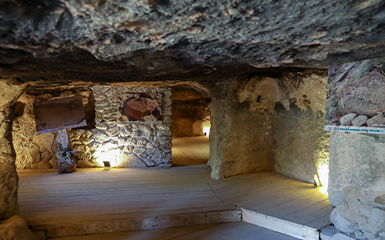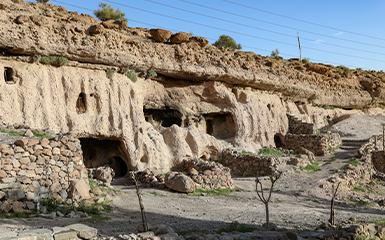Ardabil
Arg-e Bam
Abyaneh
Babak Castle
Behistun
Chogha Zanbil
Dasht-e Lut
Golestan Palace
Isfahan
Imam mosque
Kashan
Kharanaq
Mashhad
Masuleh
Meymand
Pasargadae
Naqsh-e jahan
Naqsh-e Rostam
Persepolis
Rayen Citadel
Saint Thaddeus
Saint Stepanos
Shiraz
Shushtar
Sultan Amir Ahmad
Tabriz
Takht-e Soleyman
Tehran
Tower of Silence
Yazd
Traces of its existence go back more than 12,000 years, a period located at the corners of the age of cut stone. Continuously inhabited for 3,000 years, it is one of the four oldest villages in Iran. Meymand is an incredible corner, one of a kind. It offers a wonderful panoramic view. Here the villagers have done little to add colour to the natural tones of the landscape. Their houses and streets do not have potted flowers or ornamental plants as you may find elsewhere. The austere appearance of the village is complemented by the Spartan life of its inhabitants. Without hearing a small note of music, you would think you were in the middle ages.
In this village, there is a type of dwelling called a kicheh. It usually consists of a single square or round piece. You will see some windows with an opening of about 75 cm in diameter. Otherwise, the houses have no windows and are bathed in darkness due to the lack of natural light, but also because of the soot from the fires and candles that coat the walls. Look at the doors of the apartments. They are usually made of wood and fitted with a secure lock called a koleydun. There are 406 residential units on the site with 2,560 rooms.
Enjoying a pleasant climate, the village of Meymand enjoys vegetation that consists of jujube trees, hazelnut trees, vines, almonds and others. You will find oases, which are surrounded by plowed fields, some of which have suffered from successive periods of drought. What is still marvellous about this flora is the abundance of medicinal plants it contains, such as astragalus, the most prestigious. You will also recognize other herbs like wild pistachio, cumin seeds, almond, rosemary, peppermint, etc.
Do not leave the village of Meymand without tasting some traditional dishes. In addition, God knows they are legion. However, do not miss the basic meal. It is a kind of soup with bread. Enter in the composition of this exotic dish milk and some dried herbs. It is customary to tear the bread into small pieces before throwing them into the bowl of soup. It is then after the ritual that you can enjoy the meal.
The economy of the villagers is based on agriculture, animal husbandry, carpet weaving and tourism. Meymand carpets have an international reputation. You will also distinguish auxiliary crafts such as dyeing, kilim weaving and crochet lace. The villagers learn to profit from the visit of tourists and some of the older women sell beautifully woven local baskets and some medicinal herbs. You can buy one of these items as a souvenir of your visit to the region.


